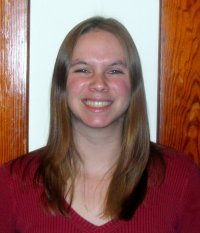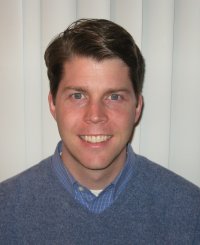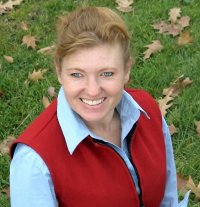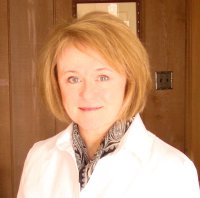 Terry M. Christensen
Terry M. Christensen Department of History Oregon State University
John Archibald Wheeler: A Study in the Pedagogy, Philosophy, and Politics of 20th Century Physics The focus of my project is the practical exercise of mentorship and leadership through the processes of apprenticeship, collaboration, and what may be called “chains of wisdom,” with John Archibald Wheeler’s career and influence in the construction of 20th-century American theoretical physics at the project’s center. In the Philadelphia area I have used two collections, the John A. Wheeler Papers at the American Philosophical Society and materials at Princeton University, where Wheeler spent the bulk of his teaching and research career.
 Melissa J. Grafe
Melissa J. Grafe Institute of the History of Medicine Johns Hopkins University
‘To attendance and medicine’: Medical practice in the Chesapeake and Mid-Atlantic regions, 1769-1820 My research centers on the medical practices of Dr. John Archer of Harford County, Maryland, his sons, and his 45 students, and how local context defined their understanding of the medical relationship and helped shape their medical careers. Archer was a graduate of the College of Medicine in Philadelphia; his sons received their medical education at the University of Pennsylvania, and a number of Archer’s students went there for training. I used the Penn Archives, which has John Archer Sr.’s medical ledger from 1775-1783, as well as files on John Archer and his students, and collections at the College of Physicians of Philadelphia, which has John Archer Jr.’s notes on Dr. Rush’s lectures and as well as information on other Archer students and Harford County doctors.
 Eric S. Hintz
Eric S. Hintz Department of History and Sociology of Science University of Pennsylvania
The Post-Heroic Generation: American Independent Inventors, 1900-1950 I am examining the changing fortunes of the American independent inventor from 1900 to 1950, exploring how this “post-heroic” generation of independent inventors adapted to changing business practices and political exigencies. My research draws on the following collections, among others: (1) at the Franklin Institute, the Case Files of the Committee on Science and the Arts; (2) at the American Philosophical Society, the correspondence of Elihu Thomson re his activities with the American Association of Inventors and Manufacturers; (3) at the Hagley Museum and Library, the papers of several 20th-century inventors, the records of the DuPont company, the papers of the National Association of Manufacturers (NAM), and the records of the Directors of Industrial Research; (4) at the Chemical Heritage Foundation, Samuel Ruben’s papers and the Oral History interviews with instrument-maker Arnold Beckman; and (5) at Penn, published resources including long runs of inventor-oriented journals and the testimony of Congress’s Temporary National Economic Committee hearings.
 Miranda Paton
Miranda Paton Department of Science and Technology Studies Cornell University
Vertebrate Paleontology and the Evolutionary Synthesis This project describes the development of evolutionary biology between 1894 and 1944 from the perspective of Henry Fairfield Osborn and George Gaylord Simpson. The aim of this history is to identify the reductive moves that Osborn resisted and Simpson embraced, as they eventually were folded into all of evolutionary biology during the Evolutionary Synthesis. The goal of my work in PACHS consortium archives is to explore Osborn’s and Simpson’s private concerns about the adequacy of their proposed synthetic descriptions of evolution as they truly could link micro-evolution (within populations and below the species level), with macro-evolution (change above the species level). I plan to use collections of correspondence between Osborn and Simpson and their colleagues within several collections held at Princeton University and the American Philosophical Society to shed light on some of the difficult questions that Osborn and Simpson seemed to ignore, dismiss or even fail to understand in their published work.
 Mary Elizabeth Zundo
Mary Elizabeth Zundo School of Fine and Applied Arts University of Illinois
Mapping Destiny: Cartography and 19th-Century American Art of the Frontier This dissertation examines the historic links between the rapid proliferation of cartographic technology in the United States, the emergence of government sponsored scientific exploration, and 19th-century American images of the frontier landscape. A sampling of relevant Philadelphia collections includes: in the American Philosophical Society, journals of Lewis and Clark, and the Charles Willson Peale correspondence; at the University of Pennsylvania, the many travel narratives, western history texts, and government survey reports; at Princeton University, Historic Map and Western Americana collections, and the Philip Ashton Rollins Collection, with numerous overland narratives and other 19th-century sources pertaining to culture west of the Mississippi; at the Wagner Institute, the comprehensive archive of 19th-century scientific survey reports and journals, government documents of the Interior, and travel; and at Academy of Natural Sciences, the wealth of original drawings, manuscripts, and journals of expedition artists, texts, government reports, travel narratives, maps, and illustrations having to do with the classification and “discovery” of the flora and fauna in the West.
 Terry M. Christensen Department of History Oregon State University John Archibald Wheeler: A Study in the Pedagogy, Philosophy, and Politics of 20th Century Physics The focus of my project is the practical exercise of mentorship and leadership through the processes of apprenticeship, collaboration, and what may be called “chains of wisdom,” with John Archibald Wheeler’s career and influence in the construction of 20th-century American theoretical physics at the project’s center. In the Philadelphia area I have used two collections, the John A. Wheeler Papers at the American Philosophical Society and materials at Princeton University, where Wheeler spent the bulk of his teaching and research career.
Terry M. Christensen Department of History Oregon State University John Archibald Wheeler: A Study in the Pedagogy, Philosophy, and Politics of 20th Century Physics The focus of my project is the practical exercise of mentorship and leadership through the processes of apprenticeship, collaboration, and what may be called “chains of wisdom,” with John Archibald Wheeler’s career and influence in the construction of 20th-century American theoretical physics at the project’s center. In the Philadelphia area I have used two collections, the John A. Wheeler Papers at the American Philosophical Society and materials at Princeton University, where Wheeler spent the bulk of his teaching and research career. Melissa J. Grafe Institute of the History of Medicine Johns Hopkins University ‘To attendance and medicine’: Medical practice in the Chesapeake and Mid-Atlantic regions, 1769-1820 My research centers on the medical practices of Dr. John Archer of Harford County, Maryland, his sons, and his 45 students, and how local context defined their understanding of the medical relationship and helped shape their medical careers. Archer was a graduate of the College of Medicine in Philadelphia; his sons received their medical education at the University of Pennsylvania, and a number of Archer’s students went there for training. I used the Penn Archives, which has John Archer Sr.’s medical ledger from 1775-1783, as well as files on John Archer and his students, and collections at the College of Physicians of Philadelphia, which has John Archer Jr.’s notes on Dr. Rush’s lectures and as well as information on other Archer students and Harford County doctors.
Melissa J. Grafe Institute of the History of Medicine Johns Hopkins University ‘To attendance and medicine’: Medical practice in the Chesapeake and Mid-Atlantic regions, 1769-1820 My research centers on the medical practices of Dr. John Archer of Harford County, Maryland, his sons, and his 45 students, and how local context defined their understanding of the medical relationship and helped shape their medical careers. Archer was a graduate of the College of Medicine in Philadelphia; his sons received their medical education at the University of Pennsylvania, and a number of Archer’s students went there for training. I used the Penn Archives, which has John Archer Sr.’s medical ledger from 1775-1783, as well as files on John Archer and his students, and collections at the College of Physicians of Philadelphia, which has John Archer Jr.’s notes on Dr. Rush’s lectures and as well as information on other Archer students and Harford County doctors. Eric S. Hintz Department of History and Sociology of Science University of Pennsylvania The Post-Heroic Generation: American Independent Inventors, 1900-1950 I am examining the changing fortunes of the American independent inventor from 1900 to 1950, exploring how this “post-heroic” generation of independent inventors adapted to changing business practices and political exigencies. My research draws on the following collections, among others: (1) at the Franklin Institute, the Case Files of the Committee on Science and the Arts; (2) at the American Philosophical Society, the correspondence of Elihu Thomson re his activities with the American Association of Inventors and Manufacturers; (3) at the Hagley Museum and Library, the papers of several 20th-century inventors, the records of the DuPont company, the papers of the National Association of Manufacturers (NAM), and the records of the Directors of Industrial Research; (4) at the Chemical Heritage Foundation, Samuel Ruben’s papers and the Oral History interviews with instrument-maker Arnold Beckman; and (5) at Penn, published resources including long runs of inventor-oriented journals and the testimony of Congress’s Temporary National Economic Committee hearings.
Eric S. Hintz Department of History and Sociology of Science University of Pennsylvania The Post-Heroic Generation: American Independent Inventors, 1900-1950 I am examining the changing fortunes of the American independent inventor from 1900 to 1950, exploring how this “post-heroic” generation of independent inventors adapted to changing business practices and political exigencies. My research draws on the following collections, among others: (1) at the Franklin Institute, the Case Files of the Committee on Science and the Arts; (2) at the American Philosophical Society, the correspondence of Elihu Thomson re his activities with the American Association of Inventors and Manufacturers; (3) at the Hagley Museum and Library, the papers of several 20th-century inventors, the records of the DuPont company, the papers of the National Association of Manufacturers (NAM), and the records of the Directors of Industrial Research; (4) at the Chemical Heritage Foundation, Samuel Ruben’s papers and the Oral History interviews with instrument-maker Arnold Beckman; and (5) at Penn, published resources including long runs of inventor-oriented journals and the testimony of Congress’s Temporary National Economic Committee hearings. Miranda Paton Department of Science and Technology Studies Cornell University Vertebrate Paleontology and the Evolutionary Synthesis This project describes the development of evolutionary biology between 1894 and 1944 from the perspective of Henry Fairfield Osborn and George Gaylord Simpson. The aim of this history is to identify the reductive moves that Osborn resisted and Simpson embraced, as they eventually were folded into all of evolutionary biology during the Evolutionary Synthesis. The goal of my work in PACHS consortium archives is to explore Osborn’s and Simpson’s private concerns about the adequacy of their proposed synthetic descriptions of evolution as they truly could link micro-evolution (within populations and below the species level), with macro-evolution (change above the species level). I plan to use collections of correspondence between Osborn and Simpson and their colleagues within several collections held at Princeton University and the American Philosophical Society to shed light on some of the difficult questions that Osborn and Simpson seemed to ignore, dismiss or even fail to understand in their published work.
Miranda Paton Department of Science and Technology Studies Cornell University Vertebrate Paleontology and the Evolutionary Synthesis This project describes the development of evolutionary biology between 1894 and 1944 from the perspective of Henry Fairfield Osborn and George Gaylord Simpson. The aim of this history is to identify the reductive moves that Osborn resisted and Simpson embraced, as they eventually were folded into all of evolutionary biology during the Evolutionary Synthesis. The goal of my work in PACHS consortium archives is to explore Osborn’s and Simpson’s private concerns about the adequacy of their proposed synthetic descriptions of evolution as they truly could link micro-evolution (within populations and below the species level), with macro-evolution (change above the species level). I plan to use collections of correspondence between Osborn and Simpson and their colleagues within several collections held at Princeton University and the American Philosophical Society to shed light on some of the difficult questions that Osborn and Simpson seemed to ignore, dismiss or even fail to understand in their published work. Mary Elizabeth Zundo School of Fine and Applied Arts University of Illinois Mapping Destiny: Cartography and 19th-Century American Art of the Frontier This dissertation examines the historic links between the rapid proliferation of cartographic technology in the United States, the emergence of government sponsored scientific exploration, and 19th-century American images of the frontier landscape. A sampling of relevant Philadelphia collections includes: in the American Philosophical Society, journals of Lewis and Clark, and the Charles Willson Peale correspondence; at the University of Pennsylvania, the many travel narratives, western history texts, and government survey reports; at Princeton University, Historic Map and Western Americana collections, and the Philip Ashton Rollins Collection, with numerous overland narratives and other 19th-century sources pertaining to culture west of the Mississippi; at the Wagner Institute, the comprehensive archive of 19th-century scientific survey reports and journals, government documents of the Interior, and travel; and at Academy of Natural Sciences, the wealth of original drawings, manuscripts, and journals of expedition artists, texts, government reports, travel narratives, maps, and illustrations having to do with the classification and “discovery” of the flora and fauna in the West.
Mary Elizabeth Zundo School of Fine and Applied Arts University of Illinois Mapping Destiny: Cartography and 19th-Century American Art of the Frontier This dissertation examines the historic links between the rapid proliferation of cartographic technology in the United States, the emergence of government sponsored scientific exploration, and 19th-century American images of the frontier landscape. A sampling of relevant Philadelphia collections includes: in the American Philosophical Society, journals of Lewis and Clark, and the Charles Willson Peale correspondence; at the University of Pennsylvania, the many travel narratives, western history texts, and government survey reports; at Princeton University, Historic Map and Western Americana collections, and the Philip Ashton Rollins Collection, with numerous overland narratives and other 19th-century sources pertaining to culture west of the Mississippi; at the Wagner Institute, the comprehensive archive of 19th-century scientific survey reports and journals, government documents of the Interior, and travel; and at Academy of Natural Sciences, the wealth of original drawings, manuscripts, and journals of expedition artists, texts, government reports, travel narratives, maps, and illustrations having to do with the classification and “discovery” of the flora and fauna in the West.